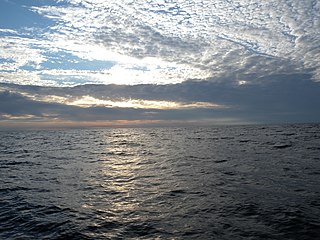
The Gulf of Saint Lawrence is the outlet of the North American Great Lakes via the Saint Lawrence River into the Atlantic Ocean. The gulf is a semienclosed sea, covering an area of about 226,000 square kilometres (87,000 sq mi) and containing about 34,500 cubic kilometres (8,300 cu mi) of water, which results in an average depth of 152 metres (499 ft).
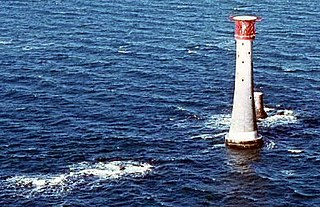
The Eddystone, or the Eddystone Rocks, are a seaswept and heavily eroded group of rocks some 9 statute miles southwest of Rame Head in Cornwall, England, United Kingdom. Formerly a treacherous hazard for ships in the approaches to the English Channel and the port city of Plymouth, the rocks have played host to four iterations of the Eddystone Lighthouse, and are still home to the current lighthouse and the stub of its immediate predecessor.

Bantry Bay is a bay located in County Cork, Ireland. The bay runs approximately 35 km (22 mi) from northeast to southwest into the Atlantic Ocean. It is approximately 3-to-4 km wide at the head and 10 km (6.2 mi) wide at the entrance.

St George's Channel is a sea channel connecting the Irish Sea to the north and the Celtic Sea to the southwest.

The North Channel is the strait between north-eastern Northern Ireland and south-western Scotland. It connects the Irish Sea with the Atlantic Ocean, and is part of the marine area officially classified as the "Inner Seas off the West Coast of Scotland" by the International Hydrographic Organization (IHO).
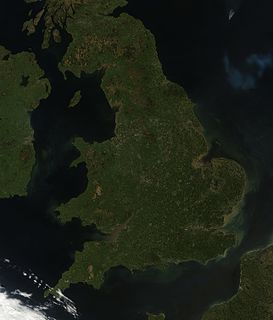
England comprises most of the central and southern two-thirds of the island of Great Britain, in addition to a number of small islands of which the largest is the Isle of Wight. England is bordered to the north by Scotland and to the west by Wales. It is closer to continental Europe than any other part of mainland Britain, divided from France only by a 33 km (21 mi) sea gap, the English Channel. The 50 km (31 mi) Channel Tunnel, near Folkestone, directly links England to mainland Europe. The English/French border is halfway along the tunnel.

The River Blackwater or Ulster Blackwater is a river in County Armagh and County Tyrone, Northern Ireland. It also forms part of the border between the United Kingdom and the Republic of Ireland, flowing between counties Tyrone and Monaghan, intersecting into Monaghan briefly. Its source is to the north of Fivemiletown, County Tyrone. The river divides County Armagh from County Tyrone and also divides County Tyrone from County Monaghan.

SM U-55 was one of the six Type U-51 U-boats of the Imperial German Navy during the First World War.
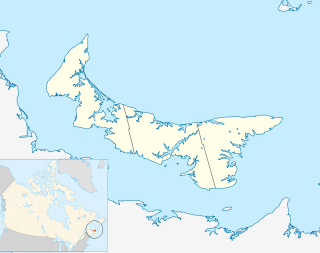
Miminegash is a municipality that holds community status in Prince Edward Island, Canada. It is located 8 miles (13 km) northwest of Alberton and 11 miles (18 km) southwest of Tignish. It is part of a small area known as either the St. Louis, Palmer Road, or Miminegash area. This area is often associated with Tignish due to the shared Acadian roots between these areas.

The Pale of Calais was a historical region in France that was controlled by the monarchs of England following the Battle of Crécy in 1346 and the subsequent siege. Pale is an archaic English term for "area, jurisdiction". The capture by the English is the subject of Auguste Rodin's 1889 sculpture The Burghers of Calais. In 1558, the expanding Kingdom of France annexed the Pale of Calais in the aftermath of the Siege of Calais.
Hunter Island is an island on the coast of the Canadian province of British Columbia. It is located inshore from Queen Charlotte Sound, about 130 kilometres (81 mi) north of the town of Port Hardy at the north end of Vancouver Island.

The Irish Sea separates the islands of Ireland and Great Britain; linked to the Celtic Sea in the south by St George's Channel, and to the Inner Seas off the West Coast of Scotland in the north by the Straits of Moyle.
HMS Capel was a Captain-class frigate, built in the United States as a Evarts-class destroyer escort, and transferred to the Royal Navy under the terms of Lend-Lease, which served in World War II.
SM U-96 was a Type U 93 submarine and one of the 329 submarines serving in the Imperial German Navy in World War I. U-96 was engaged in the naval warfare and took part in the First Battle of the Atlantic. She was launched in 1917. On 6 December 1917, she collided with the submarine SM UC-69 at Barfleur, France ; UC-69 sank with the loss of eleven of her crew. U-96 survived the war.
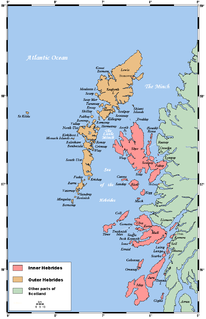
The Inner Seas off the West Coast of Scotland is a marine area designated by the International Hydrographic Organization (IHO). It consists of a number of waterbodies between the Scottish mainland, the Outer Hebrides islands, and the coast of Ireland.

The borders of the oceans are the limits of the Earth's oceanic waters. The definition and number of oceans can vary depending on the adopted criteria.
German submarine U-285 was a Type VIIC U-boat of Nazi Germany's Kriegsmarine during World War II.

HMS Vesper was a V-class destroyer of the British Royal Navy that saw service in World War I and World War II.

